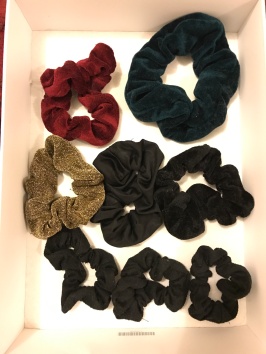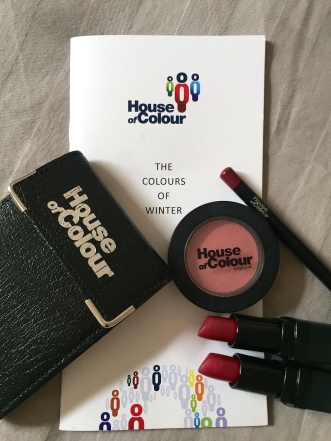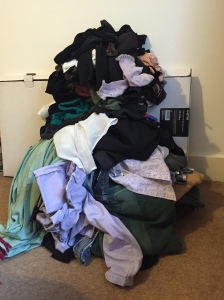Marie Kondo claims that decluttering one’s life can have a demonstrable effect on our bodies. From observing her clients, she has noted that once their houses are tidy, “their figures are more streamlined, their skin is more radiant and their eyes shine brighter”. She adds that the categories seem to have a corresponding effect on certain parts of the body – discarding clothes leads to slimmer tummies, jettisoning books and documents leads to a clearer mind, and chucking out cosmetics leads to a smooth and clear complexion. I’m not sure I can lay claim to any of these bodily benefits but once I’d discarded the ton of cosmetic and beauty products from my life, there was something else that reaped the rewards: the flat itself. Suddenly I became interested and invested in improving the aesthetic of the flat; I wanted to beautify my living space. Cosmetic improvements to the look of my living space had not been something I’d cared much about in the past. Having lived in a series of rented properties, I’d never had the inclination to do much with them – there never seemed much point as I wasn’t staying longterm. Consequently, it was like I was living on the surface of these properties, never investing much more effort than merely stringing up some buddhist prayer flags in the window. I’d always thought that once I got settled somewhere properly, then I’d make an effort with interior design. But this just meant that with my forties creeping ever closer, I was still living like a student. Seeing snaps of other people’s homes on Facebook, I was struck by how grownup they looked – they had pictures hanging on the walls, nice furniture, ornaments, soft furnishings, there was a sense of an overall aesthetic and, most importantly, they looked lived in, like a home should. Whereas my flat had the random, eclectic, no effort involved, mishmash look of a student house. An extremely clean and tidy student house for sure, but the house of someone just starting out on the road to adulthood, not the house of a woman in her late thirties. The trouble had always been, as well as not wanting to invest in a place I wasn’t going to stay, I also had no idea how to make a house look good because, fundamentally, I had no idea what I actually liked. But, with my commitment to lifestyle design and trying to create my ideal life in the present moment, along with moving into the back bedroom and throughly clearing out my cosmetics, I was suddenly imbued with the impetus I needed to spruce the place up.
The importance of imagining one’s ideal lifestyle is a cornerstone of Kondo’s philosophy. Without it, one will end up discarding but with no sense of direction and purpose. One risks being left with a barren house, devoid of not only objects but personality too. She warns that “the act of discarding things on its own will never bring joy to your life”. This is why it’s crucial to be clear about your end goal with a detailed, preferably pictorial representation, of your own personal ideal lifestyle. She urges one to think and dream big when imagining this ideal lifestyle. With Pinterest to aid my inspiration, I spent time looking at bedrooms. I had already discerned that I liked a “cosy minimalist” look. Purely minimalist bedrooms seemed too stark and cold but by adding adjectives such as “cosy” or “feminine” I discovered images that appealed to me. And upon gazing at these pictures I began to see qualities they shared. Notably, a predominance of white. Ah, a white room – the ultimate minimalist cliche! But I was no stranger to embracing cliche, I did come back from India with those prayer flags, after all.
The defining features in these pictures were white walls, white furniture and white bedlinen. I would never in a million years have bought white furniture. I always thought it was…I don’t know…twee, naff, cheap looking? I wasn’t even entirely sure why I was prejudiced against it. Yet here it was, time and time again, in these pictures that called to me and that seemed so calm, peaceful and relaxing. And then there was the “feminine” or “cosy” touches, often rendered in accents of pink. Pink! So twee, so naff, so pathetically girly! Yet…these rooms sure did look nice. And the pink wasn’t over the top, it wasn’t seven year old girl with aspirations of being a princess, it was just touches to bring a bit of warmth to the place. And I had to be honest with myself: I had actually always liked pink. Years of arguing against the pinkification of little girls with their limiting range of clothes and toys had made it seem traitorous to admit that I liked it but like it I did. And it had even featured heavily in my tomboy clothes – often as a stripe running through a polo shirt. And having discovered, from my House of Colour consultation, that strong, bright pinks were actually one of my best colours, I felt emboldened to come out as a card carrying lover of pink. Before I began this process I would have vehemently denied that I would have wanted a white room with accents of pink. I didn’t know what I wanted but I would have sworn blind that it certainly wasn’t white and pink! But if I wanted a bedroom that looked like these lovely peaceful rooms on Pinterest, I was going to have to go against my preconceptions and actually buy things in these colours. Kondo says that by tidying you can come to know yourself better; it seemed I still had a lot to learn about what I truly wanted as opposed to what I thought I wanted.
So I set about prettifying the house. Beginning with the bathroom, I discarded the shower curtain that was in a bright pattern of purple and green. I had always thought I liked things with patterns, I thought they were more interesting than something plain, and purple and green had always been colours I liked. But I replaced it with a white shower curtain with little flecks of a more shimmery white and suddenly the room seemed brighter and lighter. I also replaced the old green bath mat with a dark grey one that matched the dark grey of the lino and hand towel. My time spent on Pinterest had revealed to me that plants were of great importance to my idea of an ideal living space. But the bathroom, in the basement of the flat, lacked any natural light. Fearing that a plant would live a sad and depressing life down here, I instead bought a little fake one in a copper coloured pot. And, discarding the old plastic bin, I bought a new copper coloured metal bin. And suddenly I had a bathroom that all came together! It’s never going to be the nicest bathroom in the world, there wasn’t much I could do about the lack of natural light and its persistent dampness, but now, at least, it had a consistent colour scheme of white, grey and copper and it seemed more cohesive, stylish and grownup. Was it really this easy, I thought to myself? All you had to do was decide on some colours and buy that stuff? I had always just bought things on an individual basis, whether I happened to like that one particular thing, I had never had an overall look in mind. It’s no wonder everything about my clothes and house had been a disparate, random collection of things! Previously, I never would have bought a white shower curtain or a grey bathmat, thinking both would look terribly boring. But, in fact, they looked smart and I now saw the importance of keeping the overall look in mind and buying things that fitted that aesthetic.
Kondo warns that the bathroom can be one of the hardest areas of the house to keep tidy what with its propensity to get wet and slimy, the number of different products and supplies it holds, and that, commonly, there are multiple users of the space. Having discarded all the bath related products that were going unused and were out of date, and with my already ingrained predilection towards completely finishing a product before beginning a new one, I was left with just a small collection of items that needed storing in the bathroom. The usual suspects of shower gel, shampoo, conditioner, face wash, shaving gel and a razor had previously lived around the edge of the bath. Kondo says that storing items around the edge of the bath or on the floor of the shower cubicle is a recipe for slime. And it’s true – the bottoms of the bottles did get slimy and gross and the can of shaving gel always left a little ring of rust wherever it sat. And my razor! Literal grimness! The rubber handle, with its ridges and grooves that are obviously meant to aid grip when using it in the shower, was colonised by black mould! But Kondo offers a solution to this ecosystem of mould and slime that we allow to set up residence in our bathrooms: keep everything away from the bath and shower and put items away when you’re not using them. She instructs that, after use, items should be dried off with your bath towel and put away. In my bathroom, there is a slim chest of drawers between the sink and bath. It has four drawers which makes two each for me and my new housemate, my sister. So I bought a new razor (a Gillette Venus Swirl Flexiball which is actually really good!) and I added it, along with the shower gel, shampoo, conditioner, face wash, shaving gel, and a Tangle Teezer to the top drawer. Actually now I think about it, that Tangle Teezer is a relatively new purchase – the last one went mouldy, sitting round the bath, and it had been impossible to clean in between those tiny little rubber spines. It might seem like more work and hassle to dry everything off and put it away when you get out of the bath or shower but in reality it only takes a few seconds to wipe the bottles down with the towel, that is already at hand, and stow them back in the drawer. The bottles no longer get slimy, the shaving gel no longer leaves rust rings and the items with rubber components no longer get mouldy. And the area around the bath is now clear, clean and tidy. Also in that top drawer, I store eye makeup remover and nail polish remover. I call it the “wet drawer” because it houses liquid type products and things for use in the shower. My other designated drawer is the “dry drawer”; it houses cotton wool, toothpaste, dental floss, interdental brushes and spare toothbrush heads. Now the only things I have out in the bathroom are hand wash and my toothbrush by the sink. It’s unfortunate that the drawers in the bathroom are not high enough to apply Kondo’s strict maxim to store everything upright, so most products need to be stored lying flat. But with the products streamlined and no unnecessary extras to clutter up the space, it still looks neat and tidy and everything has its spot to slot back into after use. With the newly implemented colour scheme and with the bath and sink areas now clean and clear, the bathroom looked a whole lot better than before.
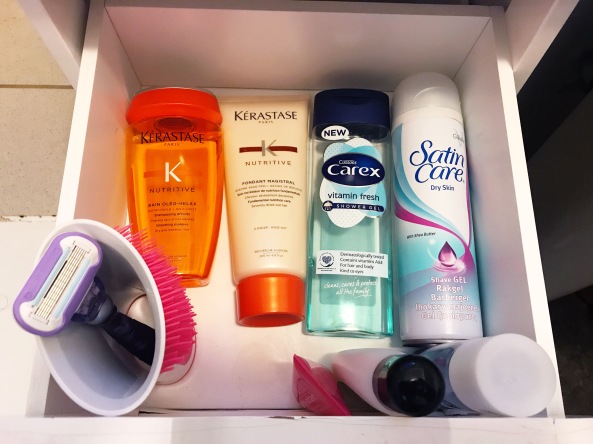
The Wet Drawer
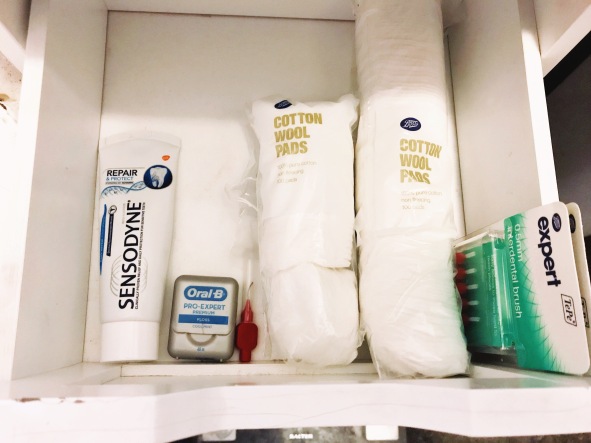
The Dry Drawer
We have a separate toilet in the flat and that too was subject to some cosmetic and beautifying improvements. Kondo points out that the toilet is the most public space in a person’s home and, therefore, appearance is important in this area. But beyond merely tidying and decluttering the space, she recommends increasing the joy factor with items that appeal to the senses, such as aroma oils, flowers, pictures and ornaments. Although clean and tidy, with the minimum of items (a bin, toilet brush, bleach and a Febreze), there was certainly room for aesthetic and sensory improvement. On the wall behind the toilet, I had a picture that brings me much joy (a framed Nintendo promotional poster from the late 1980s) but when sitting on the toilet, the only nod to aesthetics one could see was a cheap picture of Hindu Gods in a garish gold plastic frame which was perpetually slightly wonky due to an uneven bit on the back of it. While sitting there, one could either gaze upon it or the badly painted, empty corners of the room. The cheap, garish Hindu Gods picture didn’t bring me joy but I had two white tiles with Hindu Gods on that did. Previously, these had been propped up on a bookcase in my old bedroom but now I got them professionally framed and hung them in the toilet instead. I had kept my personal touch of traveller cliche but had upgraded it to something more pleasing. Kondo says toilet paper is best stored in a basket or box and, while browsing round John Lewis, I happened upon the toilet roll holders. Here was one, a cylindrical white woven basket thing, that would be perfect for the ugly corner of the toilet. So I bought the toilet roll holder. What had I become?! The sort of person who buys toilet roll holders?! Who even am I?! And it felt extremely un-minimalist to buy a toilet roll holder, a completely unnecessary item. But it sure did look better than the empty corner with its paint smeared lino. Turning my attention to the other ugly corner of the toilet, I bought a large white vase, satisfying in its size and shape, and put some pussy willow branches in it. I’ve always liked pussy willows and would stop to stroke their tiny softness whenever they were being sold in the supermarkets. Despite liking them, however, I’d never bought any, nor had anything to put them in, nor had a place to put them. But now I saw how it was possible, and indeed important, to put the effort in to create space in your life for the things you love.
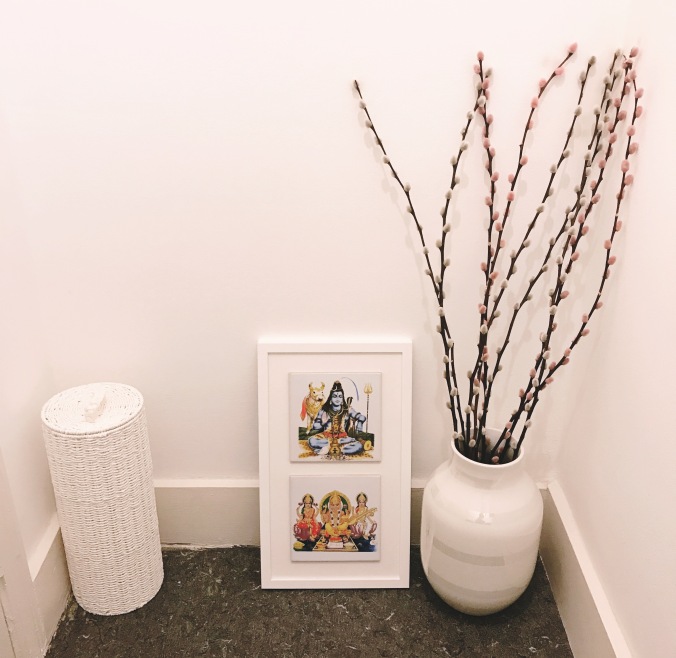
Since moving into the flat, finding a lamp for the living room had been a perennial problem. But with slowly increasing confidence in identifying what I like, I finally bought one and its soft light brings a cosy touch to the high-ceilinged room come evening time. The living room, kitchen and garden also got a few cosmetic retouches in the form of a host of plants – Theo, Ken and Jeff for the living room, Brenda and Janet for the kitchen, and Brian, Sheila, Eric and Susan for the patio. I’m not sure why but when naming plants my main inspiration seems to be the guest-list of a dinner party from the 1970s.
While I smartened up the living room, bathroom and toilet, I also made inroads to creating my ideal bedroom. Upon moving into the back bedroom, I quickly realised that the mattress was a pathetic and uncomfortable specimen who, like a passive aggressive friend, had long since given up being supportive. Luckily the landlord was amenable to a bit of bedroom beautifying and agreed to pay for a new mattress, curtains, and a white chest of drawers & bedside cabinet – both of which almost killed me to put together. I don’t whether it was the fact they were from Argos, my rubbish screwdriver or my lack of DIY ability (I suspect a combination of all three) but, dear god, they were horrifically hard to screw together. And I managed to cock it up. I nailed the backboard of the bedside cabinet to the front of it. I had to stand on it to prise it apart and there are now nail holes running down the front of it. I almost cried. But when I spoke to others, everyone seemed to have a tale of cocking up self assembly furniture which made me feel slightly better. And nail holes aside (which you can only really see if you know they’re there), it looked so good when it was all finished! The white meant both the chest of drawers and bedside cabinet blended in with the walls and didn’t overwhelm the small dimensions of the room. With the chest of drawers built, I could now store my remaining skincare and makeup komono. I headed Kondo’s advice to keep makeup and skincare products separate. She says the moist, watery nature of skincare products can compromise the quality of powder based makeup and the two should therefore be segregated. My new chest of drawers has two small drawers at the top so one became the skincare drawer housing moisturiser, eye-cream, suncream, deodorant and the like, and the other drawer became the makeup drawer. In both drawers, I stored what I could upright and the rest was laid flat.

The skincare drawer

The makeup drawer
I made sure my love of houseplants extended to the bedroom and bought a pink orchid (which I named Daphne) to go on top of the chest of drawers and a leafy green plant (which I named Howard) to sit on the floor by the bedside cabinet. These joined Larry the peace lily who was stationed on top of the wardrobe. I bought a little vase, a miniature version of the one I got for the toilet, to go next to Daphne and put up some pictures. I hung a carved wood picture above my bed, the white and brown of the exposed wood going perfectly with the white walls and wooden bed frame. And I ordered three digital pictures from the internet which I got printed and put in rose gold frames. The frames, along with the blush and rose gold tones in the pictures constituted my nod towards the more feminine touches I’d been coveting. They also represented a DIY milestone as I had to purchase a tape measure and carefully work out, pencil behind ear and tongue slightly protruding in concentration, exactly how high and far apart to hang them.

The last picture for my bedroom was of a dragon intricately and vividly embroidered in sequins and beads on a red velvet background. It was certainly not in keeping with the minimalist aesthetic of the other pictures. I’d bought it in the night bazaar in Chiang Mai in the year 2000. Even then I’d thought it was a bit much and possibly a bit tacky and I’d initially spurned the stall holder’s attempts to sell it to me. Yet something had kept drawing me back to the picture. And every time I returned to look at it, the stall holder would incrementally drop his price until it became churlish to refuse to buy it. How on earth will I get it in my backpack, I implored as my last crumbling defence. But I managed and the dragon spent a couple of years hanging from a plastic clip in the living room of one shared house I lived in. But upon moving from there, it’d been put in a bag and relegated to items to go into storage. Whenever I’d stumbled across the dragon since then, I’d gazed fondly at his bright cheery expression and lavish colourful beadwork but I’d been unsure how to properly frame his velvet backing and while living a transient life in rented house after rented house, sometimes staying no more than a couple of months, I’d never thought to ask landlords to do something as permanent as nail pictures to their walls. So the dragon hadn’t seen the light of day for over 10 years. But when I recently unearthed it from things that had been kept in storage, there was his cheerful face which had attracted me all those years before. A few beads had been lost in the intervening years but he still seemed to be smiling. This dragon undeniably brought me joy even though its over the top styling wasn’t something I normally liked. With the Konmari mindset of cherishing and displaying things that bring joy, I went to a framers to get the picture properly displayed. The framer recommended a flecked matte silver coloured wood that perfectly matched the dragon’s sequins. He now hangs opposite my bed, resplendent in his bespoke frame, and his cheerful smiling face never ceases to make me smile too.

Dragon picture, Larry the peace lily and a wire cat sculpture I made for GCSE Art.
For a long time, I’d been thinking of getting a new duvet. Every time I changed the cover, I’d be slightly perturbed by it. It was old, heavy and a tad grim. I couldn’t actually recall how long I’d had it or even where it had come from. I held out for the Special Buy sale in John Lewis and bought a new (ethically sourced) down duvet. I marvelled at its light softness – it felt so luxurious! Then I finally bought white bedlinen, the staple feature of any minimalist bedroom. I’d always thought white bedlinen was an unwise move (because periods) but having purchased a menstrual cup (a move so life-changing and revolutionary that it deserves its own blog post) I no longer needed to worry about accidental leakage. Waking up each morning under the luxurious duvet in the white bedlinen was like waking up in a smart hotel room! Slowly, over many months it had all came together. By copying elements from pictures I liked, I had created a room that I couldn’t quite believe was mine. Before my bedrooms had always just been a collection of random stuff, most of which I hadn’t really cared for but I’d accumulated it throughout my life and therefore kept it. There had never been any overall look and I’d never considered colours or actively trying to create a space I loved. I hadn’t known how to choose things. I hadn’t even known what I liked. But now I would stand in the doorway of my bedroom as I cleaned my teeth, thinking “Crikey! Look at my bedroom! It looks so nice!” And not only does it look nice, it has a wonderful calm, relaxing and peaceful feel to it which others comment on.
So the decluttering of my skincare and cosmetics had the knock on effect of beautifying the house but there was also one change to my appearance – I took my last piercing out. Previously, I’d had two piercings in my forward helix and one in my tragus. But one in my forward helix had never quite healed properly and, in the end, it annoyed me so much I’d given up and taken it out. The second piecing in the forward helix had looked lonely by itself, I’d liked the look of two but not one solitary one, so I’d removed that as well. Which left only my tragus piercing which I’d had for almost 10 years. But it just seemed that maybe I didn’t need it anymore. I spent loads of time looking at it in the mirror before I managed to pluck up the courage to get it removed. I went to the piercers in Topshop Oxford Circus to get it taken out as I was far too squeamish to attempt it myself. There’s something very final and quite emotional about taking your last piercing out. It’s a final goodbye to youth and rebellion. I was getting rid of that last little vestige that said hey, I’m not a square, check out my piercing, I’m edgy and cool! But I felt like maybe it had said what it needed to and was now superfluous to requirements. I was a little trepidatious to look at myself afterwards. Would my face seem naked, like it was lacking something? But it looked good, it looked right. It looked neater, simpler and fresher. Hello new me! And now I can fully relax at the hairdressers without that little nagging fear that they’ll accidentally catch the comb on a piercing, the mere thought of which always filled me with a gagging, retching horror. I then bought a new grownup handbag to match my new grownup face. It was the first expensive handbag I’d ever owned. But now was the time. It seemed fitting.
My piercing wasn’t the only long-standing friend to go during this time of change. After an overwatering incident, my beloved silver torch cactus, Spike, passed away. I’d had him since I was 10 years old. You’d have thought that my 29 years worth of experience looking after him would have served me better. This was actually the second overwatering accident I’d subjected him to. A couple of years ago, he began rotting when I overwatered him before going on a month-long holiday. But after amputating the affected part and applying rooting powder, I managed to revive a foot-long section of him. But this time, even with a couple of emergency amputations that saw him reduced to a tiny fraction of his former glory, I couldn’t escape the creeping rot of the Grim Reaper’s touch. I thanked him for being such a loyal friend, apologised for having failed him by giving him too much water, and buried what was left of him in the garden. Before embarking on this minimalist journey, the loss of Spike and the fact his death was entirely my fault would have hit me hard. I know he was only a plant but when you’ve nurtured something since you were 10, and if you’re a sentimental and anthropomorphic fool, you do get very attached. Maybe it was because it was touch and go for a good few months as to whether he’d make it so I was already prepared for the worst or maybe because I’m now getting better at letting go of the attachments to the past but I was more sanguine than I expected. Maybe it’s what Kondo identifies as mono no aware, or the “pathos of things”, which describes the deep emotion that is evoked when we are touched by nature, art or the lives of others with an awareness of their transience. It also refers to the essence of things and our ability to feel that essence. She says that the tidying process heightens our ability to feel this essence, allowing us to be kinder to ourselves and others. And it’s important to always be kind to yourself. Even when you’ve just killed your favourite cactus by loving it too much.
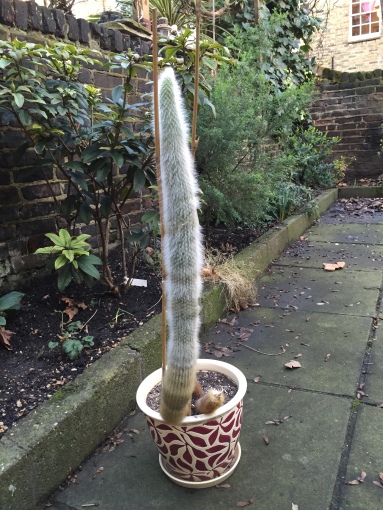
Spike. He was a great cactus.





